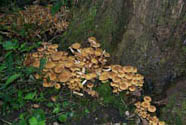 Key to Gilled Mushrooms Key
Key to Gilled Mushrooms KeyThis is a key to gilled mushrooms, that is, mushrooms having a definite cap with a fertile surface consisting of gills. The fruiting body usually also has a stem, although that may be lateral or absent (usually, then, the mushroom is growing from wood). You can use this key to identify mushrooms that you find.
 Agaricales Order
Agaricales OrderFruiting body containing fibers (usually in the stalk)
 White Spored Suborder
White Spored SuborderSpore print "light-colored": white or buff, sometimes tinged with pink or tan. Greenish and (except for the Russulales) yellow spore prints also go here
Stalk fibrous, not fracturing like a piece of chalk
 Tricholomataceae Family
Tricholomataceae FamilyNone of the special features distinguishing the other white-spored genera:
Gills not free, as in the Lepiotas and Amanitas
Basidia not extra-long, as in the Hygrophoraceae
Spores smooth, except for Lentinellus
 Lignicolous Trich Subfamily
Lignicolous Trich SubfamilyGrowing on trees or dead wood, leaves, or sticks, or organic debris, often in moss
 Normal LignoTrich Tribe
Normal LignoTrich TribeShaped like a “normal mushroom”
Small and fragile to medium-sized, except for one large, grey-capped species
Small Ligno Trich SubtribeFruiting body small: cap up to 1 1/4" across (and most clearly smaller than that)
Clitocybula Genus (Singer) Métrod
Diagnosis
- Grows in very dense clusters on wood, which is sometimes very decayed
-
Cap margin uplifted in age, but usually without losing central umbo
Microscropic Characters
Comments
As far as I'm concerned, this is a fairly confused genus: I've seen the names in it stuck on all sorts of things that don't seem to match the last species concept that I saw. Of course, it may just be me who's confused; but if so, that's why..
Narrow down your identification:
Clitocybula abundansCap up to 1 1/4" across, some shade of light tan or grey, with fine silky hairs
Gills whitish
On coniferous wood
Clitocybula familiaCap up to 1 1/2" across, some shade of light tan or grey, smooth, margin incurved when young
Gills whitish
On coniferous wood
Clitocybula lacerataCap surface radially streaked, mimicking striations; 3/4" to 2 1/2" across, in general some shade of tan or grey
On any kind of wood






 Key to Gilled Mushrooms Key
Key to Gilled Mushrooms Key Agaricales Order
Agaricales Order White Spored Suborder
White Spored Suborder Tricholomataceae Family
Tricholomataceae Family Lignicolous Trich Subfamily
Lignicolous Trich Subfamily Normal LignoTrich Tribe
Normal LignoTrich Tribe




